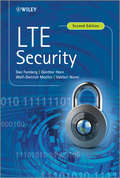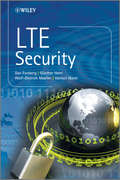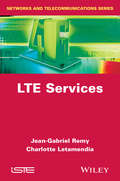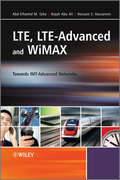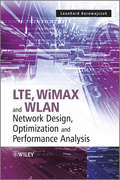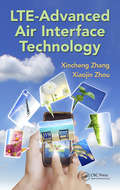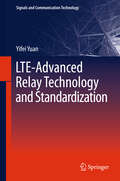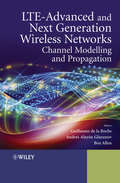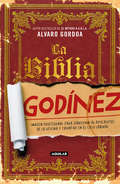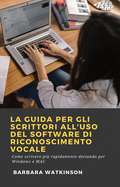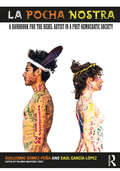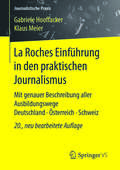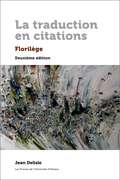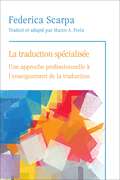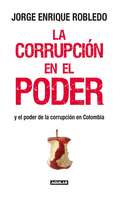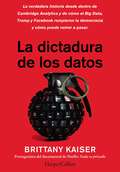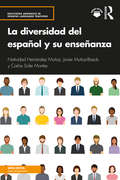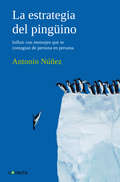- Table View
- List View
LTE Security (NSN/Nokia Series #1)
by Wolf-Dietrich Moeller Dan Forsberg Valtteri Niemi Günther HornA concise, updated guide to the 3GPP LTE Security Standardization specifications A welcome Revised Edition of the successful LTE Security addressing the security architecture for SAE/LTE, which is based on elements of the security architectures for GSM and 3G, but which needed a major redesign due to the significantly increased complexity, and different architectural and business requirements of fourth generation systems. The authors explain in detail the security mechanisms employed to meet these requirements. The specifications generated by standardization bodies only inform about how to implement the system (and this only to the extent required for interoperability), but almost never inform readers about why things are done the way they are. Furthermore, specifications tend to be readable only for a small group of experts and lack the context of the broader picture. The book fills this gap by providing first hand information from insiders who participated in decisively shaping SAE/LTE security in the relevant standardization body, 3GPP, and can therefore explain the rationale for design decisions in this area. A concise, fully updated guide to the 3GPP LTE Security Standardization specifications Describes the essential elements of LTE and SAE Security, written by leading experts who participated in decisively shaping SAE/LTE security in the relevant standardization body, 3GPP Explains the rationale behind the standards specifications giving readers a broader understanding of the context to these specifications Includes new chapters covering 3GPP work on system enhancements for MTC, plus application layer security in ETSI TC M2M and embedded smart card in ETSI SCP; Security for Machine-type Communication, Relay Node Security, and Future Challenges, including Voice over LTE, MTC, Home base stations, LIPA/SIPTO, and New Cryptographic Algorithms Essential reading for System engineers, developers and people in technical sales working in the area of LTE and LTE security, communication engineers and software developers in mobile communication field.
LTE Security (Nsn/nokia Ser. #1)
by Wolf-Dietrich Moeller Dan Forsberg Valtteri Niemi Günther HornAddressing the security solutions for LTE, a cellular technology from Third Generation Partnership Project (3GPP), this book shows how LTE security substantially extends GSM and 3G security. It also encompasses the architectural aspects, known as SAE, to give a comprehensive resource on the topic. Although the security for SAE/LTE evolved from the security for GSM and 3G, due to different architectural and business requirements of fourth generation systems the SAE/LTE security architecture is substantially different from its predecessors. This book presents in detail the security mechanisms employed to meet these requirements. Whilst the industry standards inform how to implement systems, they do not provide readers with the underlying principles behind security specifications. LTE Security fills this gap by providing first hand information from 3GPP insiders who explain the rationale for design decisions. Key features: Provides a concise guide to the 3GPP/LTE Security Standardization specifications Authors are leading experts who participated in decisively shaping SAE/LTE security in the relevant standardization body, 3GPP Shows how GSM and 3G security was enhanced and extended to meet the requirements of fourth generation systems Gives the rationale behind the standards specifications enabling readers to have a broader understanding of the context of these specifications Explains why LTE security solutions are designed as they are and how theoretical security mechanisms can be put to practical use
LTE Services
by Jean-Gabriel Rémy Charlotte LetamendiaLTE (Long Term Evolution) is commonly marketed as 4G. LTE and LTE Advanced have been recognized by ITU-R and ITU-T (International Telecommunications Union - Telecommunications) as the principal solution for the future mobile communication networks standards. They are thus the framework of what the marketing calls 4G and possibly also 5G.This book describes various aspects of LTE as well as the change of paradigm, which it is bringing to mobile communications, focusing on LTE standards and architecture, OFDMA, the Full IP Core Network and LTE security.
LTE, LTE-Advanced and WiMAX
by Hossam S. Hassanein Abd-Elhamid M. Taha Najah Abu AliA concise introduction to IMT-Advanced Systems, including LTE-Advanced and WiMAXThere exists a strong demand for fully extending emerging Internet services, including collaborative applications and social networking, to the mobile and wireless domain. Delivering such services can be possible only through realizing broadband in the wireless. Two candidate technologies are currently competing in fulfilling the requirements for wireless broadband networks, WiMAX and LTE. At the moment, LTE and its future evolution LTE-Advanced are already gaining ground in terms of vendor and operator support. Whilst both technologies share certain attributes (utilizing Orthogonal Frequency Division Multiple Access (OFDMA) in downlink, accommodating smart antennas and full support for IP-switching, for example), they differ in others (including uplink technology, scheduling, frame structure and mobility support). Beyond technological merits, factors such as deployment readiness, ecosystem maturity and migration feasibility come to light when comparing the aptitude of the two technologies.LTE, LTE-Advanced and WiMAX: Towards IMT-Advanced Networks provides a concise, no-nonsense introduction to the two technologies, covering both interface and networking considerations. More critically, the book gives a multi-faceted comparison, carefully analyzing and distinguishing the characteristics of each technology and spanning both technical and economic merits. A "big picture" understanding of the market strategies and forecasts is also offered.Discusses and critically evaluates LTE, LTE-Advanced and WiMAX (Legacy and Advanced)Gives an overview of the principles and advances of each enabling technologyOffers a feature-by-feature comparison between the candidate technologiesIncludes information which appeals to both industry practitioners and academicsProvides an up-to-date report on market and industry status
LTE, WiMAX and WLAN Network Design, Optimization and Performance Analysis
by Leonhard KorowajczukA technological overview of LTE and WiMAX LTE, WiMAX and WLAN Network Design, Optimization and Performance Analysis provides a practical guide to LTE and WiMAX technologies introducing various tools and concepts used within. In addition, topics such as traffic modelling of IP-centric networks, RF propagation, fading, mobility, and indoor coverage are explored; new techniques which increase throughput such as MIMO and AAS technology are highlighted; and simulation, network design and performance analysis are also examined. Finally, in the latter part of the book Korowajczuk gives a step-by-step guide to network design, providing readers with the capability to build reliable and robust data networks. By focusing on LTE and WiMAX this book extends current network planning approaches to next generation wireless systems based on OFDMA, providing an essential resource for engineers and operators of fixed and wireless broadband data access networks. With information presented in a sequential format, LTE, WiMAX and WLAN Network Design, Optimization and Performance Analysis aids a progressive development of knowledge, complementing latter graduate and postgraduate courses while also providing a valuable resource to network designers, equipment vendors, reference material, operators, consultants, and regulators. Key Features: One of the first books to comprehensively explain and evaluate LTE Provides an unique explanation of the basic concepts involved in wireless broadband technologies and their applications in LTE, WiMAX, and WLAN before progressing to the network design Demonstrates the application of network planning for LTE and WiMAX with theoretical and practical approaches Includes all aspects of system design and optimization, such as dynamic traffic simulations, multi-layered traffic analysis, statistical interference analysis, and performance estimations
LTE-Advanced Air Interface Technology
by Xincheng Zhang Xiaojin ZhouOpportunities are at hand for professionals eager to learn and apply the latest theories and practices in air interface technologies. Written by experienced researchers and professionals, LTE-Advanced Air Interface Technology thoroughly covers the performance targets and technology components studied by 3GPP for LTE-Advanced. Besides being an expla
LTE-Advanced Relay Technology and Standardization
by Yifei YuanLTE-Advanced relay technology and standardization provides a timely reference work for relay technology with the finalizing of LTE Release 10 specifications. LTE-Advanced is quickly becoming the global standard for 4G cellular communications. The relay technology, as one of the key features in LTE-Advanced, helps not only to improve the system coverage and capacity, but also to save the costs of laying wireline backhaul. As a leading researcher in the field of LTE-Advanced standards, the author provides an in-depth description of LTE-A relay technology, and explains in detail the standard specification and design principles. Readers from both academic and industrial fields can find sections of interest to them: Sections 2 & 4 could benefit researchers in academia and those who are engaged in exploratory work, while Sections 3 & 4 are more useful to engineers. Dr. Yifei Yuan is the Technical Director at the Standards Department of ZTE Inc.
LTE-Advanced and Next Generation Wireless Networks
by Guillaume De La Roche Andres Alayon-Glazunov Ben AllenLTE- A and Next Generation Wireless Networks: Channel Modeling and Performance describes recent advances in propagation and channel modeling necessary for simulating next generation wireless systems. Due to the radio spectrum scarcity, two fundamental changes are anticipated compared to the current status. Firstly, the strict reservation of a specific band for a unique standard could evolve toward a priority policy allowing the co-existence of secondary users in a band allocated to a primary system. Secondly, a huge increase of the number of cells is expected by combining outdoor base stations with smaller cells such as pico/femto cells and relays. This evolution is accompanied with the emergence of cognitive radio that becomes a reality in terminals together with the development of self-organization capabilities and distributed cooperative behaviors. The book is divided into three parts: Part I addresses the fundamentals (e. g. technologies, channel modeling principles etc. ) Part II addresses propagation and modeling discussing topics such as indoor propagation, outdoor propagation, etc. Part III explores system performance and applications (e. g. MIMO Over-the-air testing, electromagnetic safety, etc).
La Biblia Godínez
by Álvaro GordoaImagen profesional para sobrevivir al apocalipsis de la oficina y triunfar en el cielo laboral. En el principio Dios creó los cielos y la tierra. Luego puso hierba verde y creó los monstruos marinos y demás especies; para crear finalmente al hombre, a su imagen y semejanza. Hembra y varón fueron creados, cayeron en pecado, se pusieron un traje gris y colgaron en sus cinturas un gafete como lastre... así es como nació el Godín. Ya sea que estés en el Génesis elaborando tu CV o renunciando en pleno Apocalipsis, La Biblia Godínez te llenará de útiles recomendaciones de imagen pública para hacer de tu entorno laboral un lugar de grandes oportunidades para tu crecimiento profesional. Pasando por Los 10 Mandamientos de la imagen profesional como #Santificarás las fiestas corporativas# y #No desearás a la mujer ni al hombre de tu cubículo# o Los 7 Pecados capitales de la oficina como #La gula# que provoca el Mal del puerco o #La avaricia# que te ayudará a pedir aumentos y ganar más; La Biblia Godínez es un texto indispensable para quien desea ascender a los cielos profesionales y convertirse en una deidad de la oficina. Entre otras cosas aprenderás a: - Prepararte exitosamente para una entrevista de trabajo. - Producirte físicamente para trabajar. - Ganarte a tus jefes para ascender en la organización. - Comportarte eficientemente en juntas y citas de negocios. - Lidiar con envidias, crisis y hasta romances de oficina. ¡Qué esperas, pasa de ser un Godín a un God-IN!
La Biblia Godínez
by Álvaro GordoaImagen profesional para sobrevivir al apocalipsis de la oficina y triunfar en el cielo laboral. En el principio Dios creó los cielos y la tierra. Luego puso hierba verde y creó los monstruos marinos y demás especies; para crear finalmente al hombre, a su imagen y semejanza. Hembra y varón fueron creados, cayeron en pecado, se pusieron un traje gris y colgaron en sus cinturas un gafete como lastre... así es como nació el Godín. Ya sea que estés en el Génesis elaborando tu CV o renunciando en pleno Apocalipsis, La Biblia Godínez te llenará de útiles recomendaciones de imagen pública para hacer de tu entorno laboral un lugar de grandes oportunidades para tu crecimiento profesional. Pasando por Los 10 Mandamientos de la imagen profesional como #Santificarás las fiestas corporativas# y #No desearás a la mujer ni al hombre de tu cubículo# o Los 7 Pecados capitales de la oficina como #La gula# que provoca el Mal del puerco o #La avaricia# que te ayudará a pedir aumentos y ganar más; La Biblia Godínez es un texto indispensable para quien desea ascender a los cielos profesionales y convertirse en una deidad de la oficina. Entre otras cosas aprenderás a: - Prepararte exitosamente para una entrevista de trabajo. - Producirte físicamente para trabajar. - Ganarte a tus jefes para ascender en la organización. - Comportarte eficientemente en juntas y citas de negocios. - Lidiar con envidias, crisis y hasta romances de oficina. ¡Qué esperas, pasa de ser un Godín a un God-IN!
La Guida per gli Scrittori All'uso del Software di Riconoscimento Vocale: Come scrivere più rapidamente dettando per Windows e MAC
by Barbara WatkinsonSapevi che i software per la dettatura possono aiutarti a scrivere un libro fino a 3 volte più rapidamente? Vuoi riuscire a scrivere un romanzo in modo più rapido ed efficace? Se hai risposto di sì, allora questa pubblicazione fa al caso tuo! Questa guida è farcita di una miriade di strategie per dettare un romanzo comodamente dal tuo salotto e senza toccare la tastiera! Ecco gli argomenti trattati del libro: Come iniziare Come preparare una bozza Le migliori applicazioni per la scrittura vocale Come usare il software per la dettatura per pubblicare un romanzo e MOLTO ALTRO! Se vuoi imparare a scrivere un romanzo dettando, allora questo libro fa per te! --> Vai in cima alla pagina e clicca su aggiungi al carrello per acquistarlo subito Disclaimer: L'autore e/o il titolare o i titolari dei diritti non danno alcuna certezza, non fanno alcuna promessa e non forniscono alcuna garanzia sulla precisione, sulla completezza o sull'adeguatezza dei contenuti della presente opera e declinano espressamente la responsabilità per qualsiasi errore e omissione nel suo contenuto. Questo prodotto è destinato al solo utilizzo come riferimento.
La Pocha Nostra: A Handbook for the Rebel Artist in a Post-Democratic Society
by Guillermo Gómez-Peña Saúl García-LópezLa Pocha Nostra: A Handbook for the Rebel Artist in a Post-Democratic Society marks a transformation from its sister book, Exercises for Rebel Artists, into a pedagogical matrix suited for use as a performance handbook and conceptual tool for artists, activists, theorists, pedagogues, and trans-disciplinary border crossers of all stripes. Featuring a newly reworked outline of La Pocha Nostra's overall pedagogy, and how it has evolved in the time of Trump, cartel violence, and the politics of social media, this new handbook presents deeper explanations of the interdisciplinary pedagogical practices developed by the group that has been labeled "the most influential Latino/a performance troupe of the past ten years." Co-written by Guillermo Gómez-Peña in collaboration with La Pocha Nostra’s artistic co-director Saúl García-López and edited by Paloma Martinez-Cruz, this highly anticipated follow-up volume raises crucial questions in the new neo-nationalist era. Drawing on field experience from ten years of touring, the authors blend original methods with updated and revised exercises, providing new material for teachers, universities, radical artists, curators, producers, and students. This book features: Introductions by the authors and editor to Pocha Nostra practice in a post-democratic society. Theoretical, historical, poetic, and pedagogical contexts for the methodology. Suggestions for how to use the book in the classroom and many other scenarios. Detailed, hands-on exercises for using Pocha Nostra-inspired methods in workshops. A step-by-step guide to creating large-scale group performances. New, unpublished photos of the Pocha Nostra methods in practice. Additional texts by Reverend Billy and Savitri D., Dragonfly, Francesca Carol Rolla, VestAndPage, Micha Espinosa, Zulfikar Ali Bhutto, Praba Pilar, L. M. Bogad, Anuradha Vikram, and Annie Sprinkle and Beth Stephens, among many others. The book is complemented by the new book Gómez-Peña Unplugged: Texts on Live Art, Social Practice and Imaginary Activism (2008–2019).
La Roches Einführung in den praktischen Journalismus
by Klaus Meier Gabriele HooffackerWie wird man heute Journalist? Wo und in welchen Funktionen arbeiten Journalisten? Wie verändern die neuen Medien den Journalistenberuf? Wo kann man Journalismus lernen? Wie findet man Kontakt zu einer Redaktion? Wie recherchiert man eine Story? Kann der Journalist objektiv informieren? Wie schreibt man eine Nachricht? Was sind die Besonderheiten von Bericht, Reportage, Interview, analysierendem Beitrag und Feature sowie von Kommentar, Glosse und Rezension? Auf diese Fragen gibt die neu bearbeitete 20. Auflage erprobte und bewährte Antworten, aber auch Auskünfte über den neuesten Stand journalistischer Arbeitstechniken und Ausbildungsmöglichkeiten. Vor dem Hintergrund des digitalen Journalismus wurde das Kapitel zum Thema Recht völlig neu gefasst. Aufwändig recherchiert und überarbeitet wurden die Wege in den Journalismus, insbesondere die immer wichtiger werdenden Studiengänge an Hochschulen.
La Traduction en citations, deuxième édition: Florilège (Regards sur la traduction)
by Jean DelisleTraduire, ce n’est pas écrire » / « Traduire n’est rien d’autre qu’écrire » « On naît traducteur, on ne le devient pas » / « Le métier de traducteur, ça s’apprend » Qu’en pensent Victor Hugo, Madame de Sévigné, Octavio Paz ou Umberto Eco? Et qu’en disent les théoriciens de la traductologie, comme Antony Pym ou Sherry Simon? Les idées s’entrechoquent allègrement dans ce florilège de citations : autant d’auteurs et de traducteurs, autant de partis pris sur l’acte de traduire. La traduction en citations contient plus de 2700 aphorismes, définitions, éloges, épigrammes, jugements, témoignages ou traits d’esprit sur la traduction, les traducteurs et les interprètes. Ces citations ont été glanées chez plus de huit cents auteurs, de l’Antiquité à nos jours et sont classées sous une centaine de thèmes tels que Art ingrat, Belles infidèles, Éloge du traducteur, Humour, Limites de la traduction, Traduire au féminin ou Vieillissement des traductions. Ce petit bijou, agréable à lire et à relire, est un incontournable sur la table de chevet de tout traducteur et de tout lecteur curieux. Sourires en coin garantis. Publié en français
La Traduction spécialisée: Une approche professionnelle à l’enseignement de la traduction (Regards sur la traduction)
by Federica ScarpaCet ouvrage présente les fondements théoriques et les principes méthodologiques de la traduction spécialisée en général, et plus particulièrement de la traduction spécialisée de l'anglais vers le français. Il s'ouvre sur une description des particularités des langues de spécialité portant sur une typologie des textes et une classification des genres textuels. Une étude comparative fait ressortir les similitudes et les différences qui marquent la langue de spécialité par rapport à la langue générale. L'ouvrage présente ensuite des stratégies à adopter dans la traduction d'un texte à partir de trois perspectives : les caractéristiques textuelles et rhétoriques du texte spécialisé, les aspects morphosyntaxiques de la langue de la spécialité et finalement, les aspects lexicaux et terminologiques du type textuel. Des chapitres entiers abordent les caractéristiques de la traduction de textes spécialisés, la notion d'équivalence, la méthodologie de la traduction spécialisée et le contrôle de la qualité des traductions. L'ouvrage se termine par un chapitre sur les débouchés qui s'offrent au langagier qui s'apprête à entreprendre une carrière de communicateur interlinguistique spécialisé. Publié en français
La caza sutil: (1953-1994)
by Julio Ramón Ribeyro"[Este libro] no pretende ser un safari por los dominios de la crítica literaria, sino un desaprensivo paseo entre libros y autores, recogiendo aquí y allá una que otra pequeña presa". Julio Ramón Ribeyro
La caída de las AFP
by MAURICIO WEIBELUna impactante investigación periodística que revela una historia de operaciones ilegales, fraudes y paraísos fiscales Después de cuarenta años desde que se privatizó el sistema de pensiones en Chile, durante la dictadura, las AFP han perdido su legitimidad social a golpe de irregularidades y pensiones bajo la línea de la pobreza para la gran mayoría de las personas. La más reciente investigación de Mauricio Weibel, autor de Traición a la patria, describe cómo un sistema que ampara la preeminencia del mercado sobre los derechos sociales, ha permitido el abuso y los fraudes a cuenta del futuro de los chilenos. El autor reconstruye la historia de los conflictos de interés y las operaciones ilegales que han atravesado el sistema privado de pensiones en Chile en los últimos años. Con testimonios inéditos y documentos exclusivos deja al descubierto una trama que incluye pensiones de invalidez negadas, desfalcos bursátiles, lujos castrenses y paraísos fiscales
La corrupción en el poder: Y el poder de la corrupción en Colombia
by Jorge Enrique RobledoUn libro llamado a revelar los niveles de corrupción, politiquería y demagogia a los que ha llegado Colombia: Transmilenio, Saludcoop, Isagén, Reficar y las Zidres. (Para ver las transcripciones de los debates del senador Robledo sobre los temas tratados en este libro por favor copie el siguiente link y péguelo en una ventana nueva: http://bit.ly/2h0EOqM ) Con la rigurosidad que lo caracteriza, Jorge Enrique Robledo explica de manera sencilla y directa qué hubo detrás de los grandes desfalcos y escándalos de corrupción en Colombia en los últimos años. Reconocido como uno de los senadores más respetados de Colombia, Robledo presenta un libro revelador que promete levantar ampolla: como resultado de una exhaustiva y valiente investigación revela los detalles más sorprendentes de cómo se han ejecutado proyectos y negocios que involucran las más estratosféricas sumas de dinero con el único objetivo de lucrar a empresarios y entregar beneficios non sanctos a representantes de diferentes gobiernos y a políticos colombianos. Su investigación devela los casos de Transmilenio en Bogotá, Reficar en Cartagena, Saludcoop, Isagén y las Zonas de Interés de Desarrollo Rural, Económico y Social (Zidres) que busca arrebatarle la tierra a los campesinos y mal usar los terrenos baldíos de la Nación para entregárselos a particulares.
La dictadura de los datos: La verdadera historia desde dentro de Cambridge Analytica y cómo el Big Data, Trump y Facebook corrompieron la democracia, y cómo puede volver a pasar
by Brittany KaiserBrittany Kaiser, una ex directiva de Cambridge Analytica, la empresa que se dedicó durante años a manipular procesos electorales en numerosos países del mundo, cuenta cómo fue que Facebook y las transnacionales de internet torcieron el proceso electoral en el que Donald Trump ganó la Presidencia de Estados Unidos.Ella revela cómo las políticas laxas de Facebook y la falta de leyes nacionales permitieron que los votantes fueran manipulados tanto en Gran Bretaña como en los Estados Unidos, donde se adjudicaron datos personales para difundir noticias falsas y mensajes racistas durante la votación del Brexit y la elección estadunidense de 2016. Pero el daño no ha terminado, advierte Kaiser. La elección de 2020 también puede verse comprometida.Kaiser tomó la difícil decisión de exponer la verdad arriesgando su carrera, sus relaciones y su seguridad personal. Habló a las autoridades sobre las prácticas comerciales poco éticas de la industria de los datos, y finalmente testificó ante el Congreso de los Estados Unidos, ayudando a la investigación del abogado Robert Mueller sobre la interferencia de Rusia en las elecciones de 2016, junto con al menos otras 10 investigaciones internacionales.Repleto de historias e ideas nunca antes contadas públicamente, Kaiser aboga por la regulación, argumentando que la supervisión legal de la industria de los datos no solo es justificable, sino esencial para garantizar la seguridad a largo plazo de nuestra democracia.
La diversidad del español y su enseñanza (Routledge Advances in Spanish Language Teaching)
by Javier Muñoz-Basols Natividad Hernández Muñoz Carlos Soler MontesLa diversidad del español y su enseñanza es la primera publicación concebida para reflexionar sobre la diversidad de la lengua desde un punto de vista crítico, interdisciplinario, institucional, aplicado e internacional. El análisis de doce lecturas y de una detallada guía de explotación didáctica potencian la adquisición de conocimientos sobre la lengua y desvelan la complejidad de la investigación sobre las variedades del español. Características principales: • Artículos de investigación desde diferentes enfoques y perspectivas; • Actividades de reflexión para verificar la asimilación de contenidos; • Análisis crítico de extractos y citas de autoridad (español e inglés); • Preguntas analíticas sobre el estado de la cuestión y recursos institucionales; • Modelos metodológicos de investigación empírica sobre la diversidad de la lengua; • Propuestas de temas para la investigación y el debate dentro y fuera del aula; • Pautas bibliográficas detalladas para profundizar sobre la materia; • Selección de conceptos clave para potenciar la adquisición de terminología lingüística; • Glosario bilingüe en línea (español e inglés) sobre variedades del español, sociolingüística aplicada y política lingüística; • Soluciones de las guías de lectura e información complementaria. Diseñado como libro de texto o material de autoaprendizaje, La diversidad del español y su enseñanza es una herramienta imprescindible para familiarizarse con la diversidad de la lengua. La información será de interés y aplicable en contextos académicos y profesionales de enseñanza, diseño curricular y elaboración de materiales didácticos de español como lengua extranjera o segunda y de herencia. Cualquier investigador, profesor, estudiante o lector podrá acceder de manera crítica y pautada a esta importante parcela de conocimiento sobre el idioma. La diversidad del español y su enseñanza brings together twelve articles that investigate Spanish linguistic variation and the impact this has on Spanish language teaching. Based on a special edition of the Journal of Spanish Language Teaching, each chapter here presents an article from the Journal with an additional reading guide designed to transform the information into a pedagogical tool that can be used and applied in the classroom. Each article is accompanied by critical analysis, reflection activities, questions for future research and debate, and suggestions for further reading. A bilingual glossary covering key terms within Spanish language variation, applied sociolinguistics and language policy is available online at www.routledge.com/9780367651695. This book is a practical overview of the evolution and current state of the study of Spanish language variation and will be of most interest to researchers and teachers of Spanish as a second language who will gain insight into how to include linguistic variation in their teaching.
La escuela de WordPress de 5 días: cómo convertirse en un diseñador de sitios web de WordPress en 5 días o menos
by Cyrus M. Jackson¿Le encantaría aprender cómo configurar (fácilmente), diseñar (profesionalmente) y asegurar (adecuadamente) los sitios de WordPress que matan (incluso si no tiene conocimientos previos de codificación o temas técnicos)? Entonces, ¡la "Escuela de WordPress de 5 días" es la guía más autorizada que necesitarás! Ya no es una novedad que WordPress es la mejor plataforma de blogs del planeta y el sistema de administración de contenido más popular que puede encontrar hoy en día, que controla el 52% de los sitios web en Internet (según Technorati) que habla sobre el volumen de su eficiencia y sus increíbles funciones. No es de extrañar que los sitios web autorizados en Internet (como CNN, New York Times, HuffingtonPost, Mashable ...) estén basados en la plataforma WordPress. WordPress es la bomba: ¿quieres quedarte fuera? Cyrus Jackson, un diseñador profesional de WordPress, lo lleva de la mano sobre cómo dominar la plataforma de WordPress de manera efectiva: desde la configuración, hasta el diseño, la seguridad ... de una manera de ladrillo a ladrillo con abundantes ilustraciones, capturas de pantalla. , gráficos y pautas paso a paso para brindarle el mapa de ruta necesario sobre cómo configurar su sitio web de WordPress de manera profesional para una audiencia web. Y sí: el libro puede convertirte en un diseñador profesional de WordPress en 5 días, incluso si este es tu primer intento de iniciar una plataforma en línea. ¡En serio! Estos son los temas que se tratan en este libro asombroso, fácil de leer, asombroso y para principiantes: Una explicación detallada de la plataforma de WordPress. Entendiendo el panel de WordPress Configuración de su sitio web de WordPress auto-alojado Todo lo que necesitas saber sobre alojamiento web y registro de dominios. Los mejores servidores web que son fiables y asequibles. Consejos importantes a seguir al elegir un aloj
La estrategia del pingüino
by Antonio NúñezEl declive de las comunicaciones masivas y el triunfo de las tecnologías han provocado una explosión de información que crece de manera vertiginosa y fragmenta la opinión pública. Comunicar hoy es propagar. Las espirales irracionales, los rumores en cadena y los pronósticos impulsivos terminan por hacer mella en la confianza de clientes, socios, expertos, líderes de opinión y medios de comunicación.La estrategia del pingüino revela las claves de la comunicación de persona en persona. Su lectura te permitirá influir en cómo los demás perciben tus mensajes y, lo más importante, en cómo estos los transmiten a su red de personas de confianza.
La estrategia del pingüino: Influir con mensajes que se contagian de persona en persona
by Antonio NúñezTodas las claves para influir en el nuevo entorno de las comunicaciones en cadena, a tiempo real y de persona en persona. El declive de la comunicación de masas y el triunfo de las tecnologías de comunicación de persona en persona han provocado una explosión de información que crece de manera vertiginosa y fragmenta la opinión pública. Comunicar hoy es propagar. Las espirales irracionales, los rumores en cadena y los pronósticos impulsivos terminan por hacer mella en la confianza de clientes, socios, expertos, líderes de opinión y medios de comunicación. La estrategia del pingüino le revela las claves de la comunicación de persona en persona. Su lectura le permitirá influir en cómo los demás perciben sus mensajes y, lo más importante, en cómo estos los transmiten a su red de personas de confianza Los expertos opinan:«Con el nervio de un thriller, Antonio Núñez disecciona las contradicciones que generaun mundo de comunicaciones fuera de control. Una trepidante detonación de consejos prácticos y optimismo.»Dr. Jordi Montaña, catedrático del departamento de dirección de marketing, ESADE Business School «Este libro es un paso más allá del storytelling. Encierra un profundo conocimiento de nuestra naturaleza gregaria, y una buena acumulación de casos para entender por qué la gente opina y actúa como lo hace. Nadie lo ha explicado con la claridad y la inteligencia de Antonio.»Luis Arroyo, presidente de ACOP, Asociación de Comunicación Política, y consultor internacional «Estudiando el compañerismo y la solidaridad de los pingüinos, Antonio proporciona las claves para lograr una comunicación más personal y fiable en un entorno empeñado en mostrarse cada día más gélido.»Gregorio Panadero, director global de comunicación e imagen de Grupo BBVA «Esta es la época del fin del intermediario: en la comunicación, en el comercio, en la moda o en la política. El tú a tú teje la red que lo cubre todo y este libro sirve para conocer cabalmente cómo se hila el nuevo mundo.»Vicente Verdú, sociólogo y autor de El capitalismo funeral
La farmacéutica: 492 días secuestrada
by Carles PortaHas oído hablar de esta historia, pero ni la conoces entera ni te la han contado nunca así. *****INCREÍBLEMENTE REAL***** «El 20 de noviembre de 1992 secuestraron a Maria Àngels Feliu Bassols, farmacéutica de Olot. Esta mujer, madre de tres hijos, pasó dieciséis meses bajo tierra, enterrada viva en un agujero del tamaño de un armario. Arañas, hormigas, ratas, serpientes y humedad fueron sus compañeras de cautiverio.» Así empieza la historia increíblemente real de uno de los casos más extremos de la crónica negra española. Aquel crimen se transformó en un drama humano cuya investigación, repleta de errores policiales y judiciales, estuvo acompañada de vergonzosos ejemplos de periodismo basura. Por si fuera poco, los captores de Maria Àngels se mostraron incapaces de culminar el secuestro exprés que habían planeado. Lo único que lograron fue eternizar el suplicio de una mujer que sobrevivió a tan adversas circunstancias gracias a su determinación y su fortaleza psíquica. Tras ser liberada, aún tuvieron que transcurrir cinco años para que los responsables fueran detenidos y otros cuatro para juzgarlos. Después de revisar a fondo la información generada por el suceso, Carles Porta ha reconstruido el caso al completo, en un único hilo narrativo. No existe otra recreación tan rigurosa de todas las historias entrecruzadas que rodearon el secuestro de la farmacéutica de Olot. Sin duda, con este libro Porta se consagra como uno de los maestros del periodismo narrativo de nuestro país. La crítica ha dicho sobre Tor, la montaña maldita:«Truman Capote, James Ellroy o Emmanuel Carrère han demostrado que se puede hacer gran literatura utilizando tan solo los datos reales de un crimen, por archiconocido que este sea. Por estas tierras, Carles Porta ya lo dejó claro con Tor, la montaña maldita.»Xavi Ayén, La Vanguardia «Un excelente trabajo periodístico.»María José Obiol, Babelia «Se lee como una muy buena novela.»Kiko Amat, Cultura/s Sobre Fago. Si te dicen que tu hermano es un asesino:«Un libro fantástico y emocionante, [...] digno representante del periodismo literario.»Óscar López, Página Dos «Su calidad literaria es inapelable. [...] Una obra profunda y poderosa.»Pere Antoni Pons, Ara Sobre Le llamaban padre:«Periodismo en profundidad, y próximo. Una gran investigación.»Ignacio Orovio, La Vanguardia
La fuerza de ser altamente sensible: Descubre si lo eres y aprende de tu poder creativo
by Meritxell Garcia¿Sabías que el 30% de la población es Persona Altamente Sensible (PAS)? Aprende claves y trucos para que este rasgo de la personalidad se convierta en un superpoder. ¿Tienes un olfato fino y oyes el mínimo ruido? ¿Te agobias en lugares con mucha gente? ¿Observas sutilezas que pasan desapercibidas para la mayoría? ¿Te molestan las etiquetas de la ropa?. Si has respondido afirmativamente, es posible que seas una persona altamente sensible (PAS): tu cableado neurológico es distinto, percibes más información que el resto de la gente a través de los sentidos, y muchas veces, este alud de estímulos te satura. Cuando entiendas cómo funciona tu maquinaria PAS, descubrirás que la alta sensibilidad puede jugar a tu favor si sabes cómo hacerlo. Este libro te enseña cómo sacar partido de tu naturaleza sensible y creativa, descubrir tu potencial y brillar y construir una vida plena acorde con tu personalidad.
